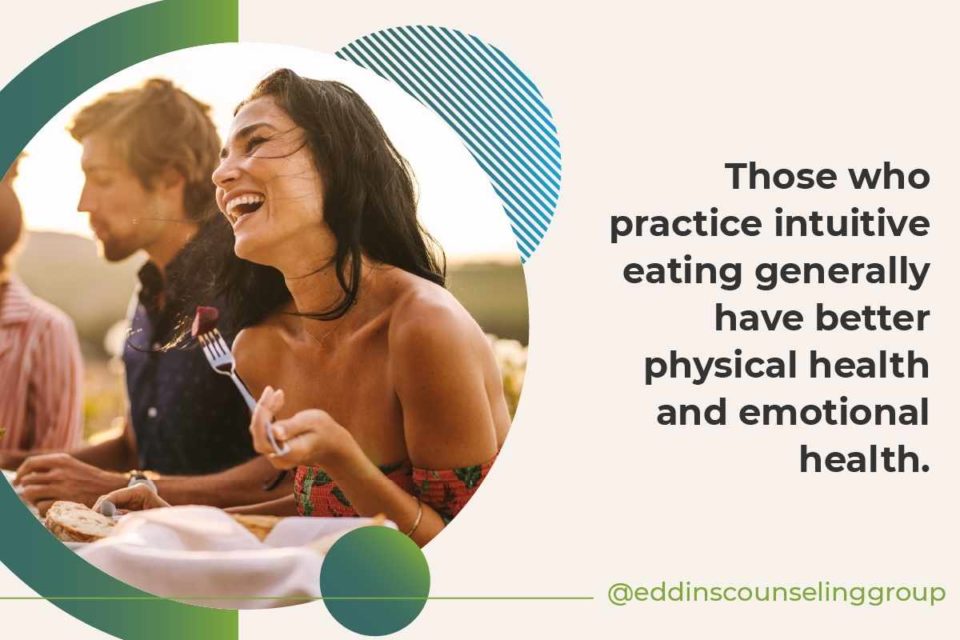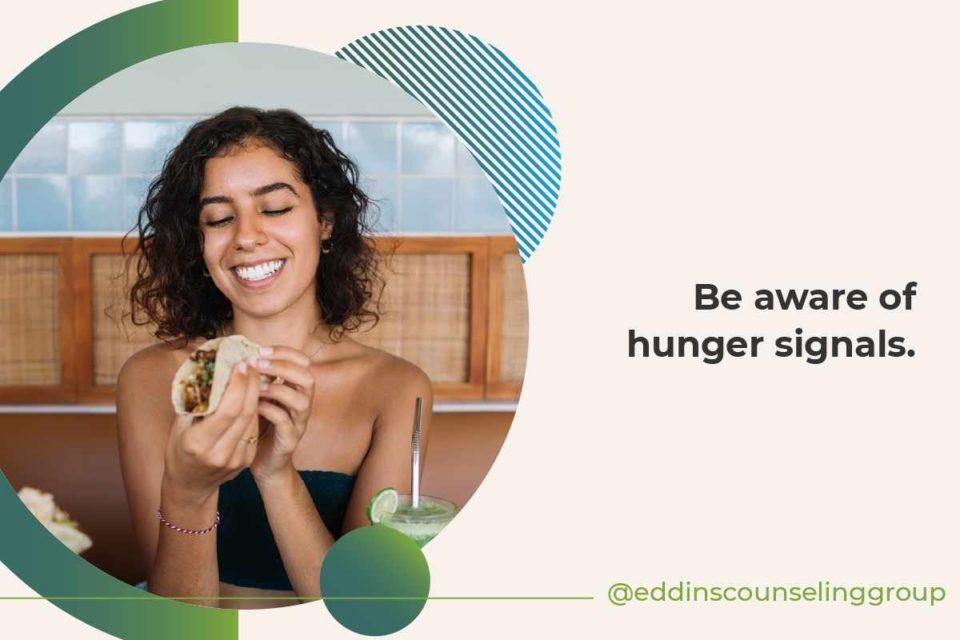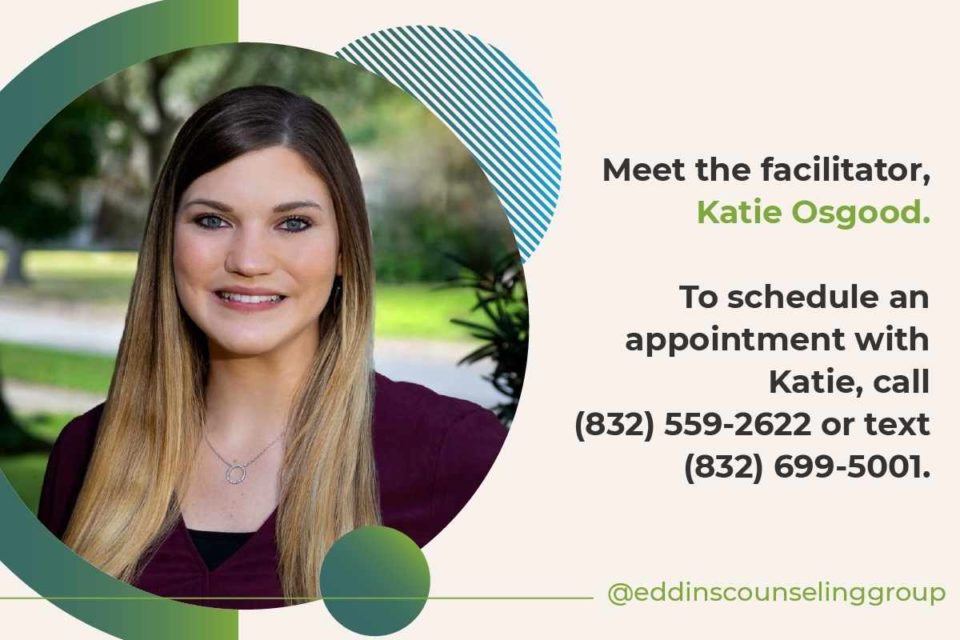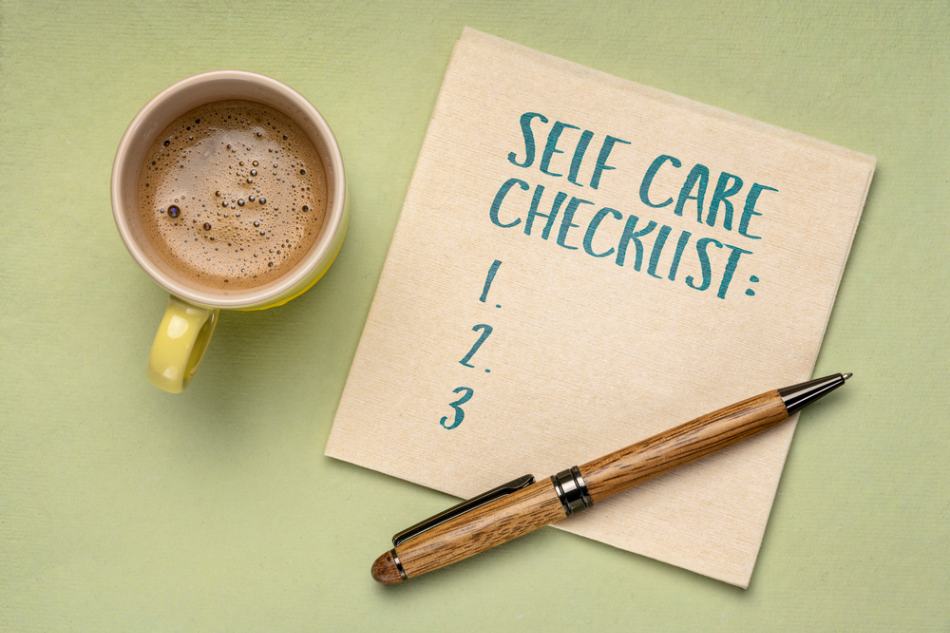November 11, 2021
Webinar: Practicing Intuitive Eating in Your Daily Life
Written by Rachel Eddins
Posted in Emotional Eating & Body Image, Webinars and with tags: Emotional Eating, disordered eating, eating disorders

Learn ways you can make peace with food and begin incorporating intuitive eating principles in your daily life.
Facilitated by Katie Osgood, Practicum Student.
Watch a replay of the presentation here.
Learn more about our emotional eating therapy services.
Here is a transcript of the webinar:
Hello! I’m Katie Osgood, and I’m a Licensed Professional Counselor – Associate* here at Eddins Counseling Group. I’m also under the supervision of another therapist here. (*edited from original transcript since she graduated/became licensed)
I love talking about intuitive eating for two reasons:
- I feel like not that many people know about it, and
- I’ve also had my own personal journey with intuitive eating growing up.
I think everybody struggles with a little bit of body image type stuff with today’s society and the messages that we get but at times in my life found myself being like: “Okay, I’m going to start over on Monday, this will be the Monday”, and it just keeps becoming a cycle.
And so at one point a couple of years ago, I was like, there has to be something else, there has to be another option than just this continual diet cycle. And then I found intuitive eating. I just get excited to share it with you guys because I really feel like it can make a difference with the way you approach food and your body in general.
What Is Intuitive Eating?
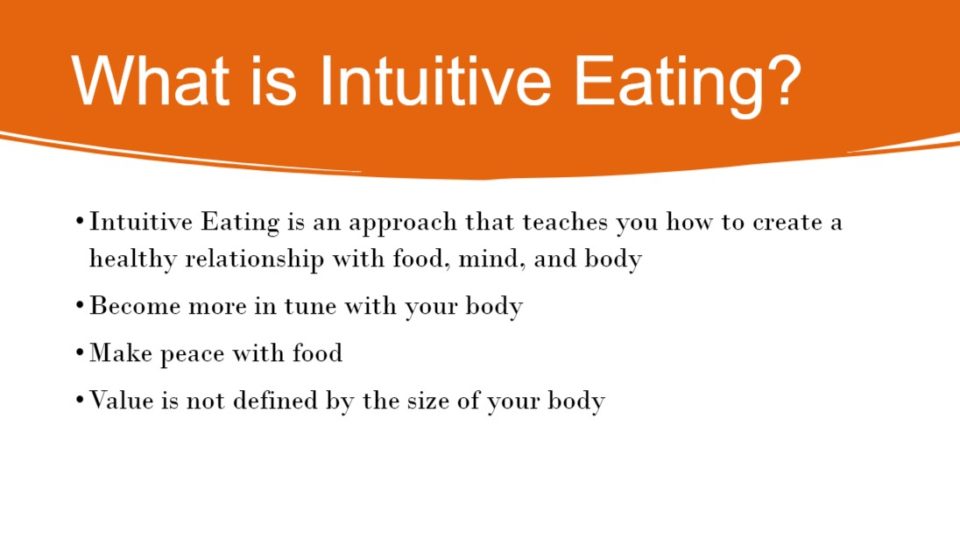
I’m going to give a brief overview of actually what intuitive eating is. We could have people here that have been practicing intuitive eating for a year or two and are looking for some tips and tricks, we could ask people that are just at the beginning of their journey or have just heard the word intuitive eating when they saw this advertisement for their webinar.
So I want to give a little brief background on what it is, where did it come from? That way we’re all starting from the same page.
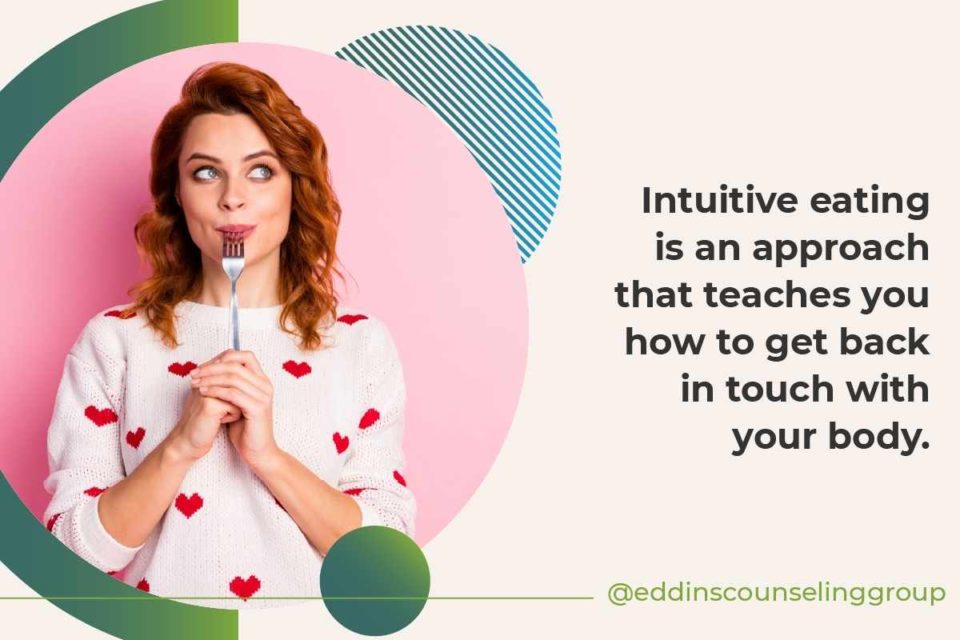
Intuitive eating is an approach that teaches you how to get back in touch with your body, with your physical hunger cues, and helps you to create a healthier relationship with your food, the way you think about food, and the way you think about your body.
When you’re a child, you eat just because you eat. Even when you’re a baby, you cry because you’re hungry, and then when you’re not hungry, you stop eating. As a child, your body physically tells you you’re hungry, and your body physically tells you when you’re full. And so that’s how you know.
It’s very simple as a kid, but over time, with everything that all these messages that we hear growing up and diet culture and everything, as you get into your teenage years, when you really start that comparison between your peers and other things that we get from our society in general.
For women, being thin is beautiful. For men, they are supposed to be strong, they are supposed to be muscular.
Just those messages that are pushed on us, you start to lose the physical hunger cues. You start to lose that actual physical sensation in your body saying: “Yes, I’m hungry now. Let’s stop eating because I’m full”. You start eating with your head basically. All the thoughts up here: “Okay, I’m not going to eat chocolate. I’m going to not eat after 09:00 p.m. I’m only going to eat between 08:00 a.m. And 08:00 p.m.”
Those types of things you’re thinking with your head, you’re eating with your head. So you lose the cues of your physical hunger. So intuitive eating is trying to figure out, how we get those back. And then just finding a way to be more accepting of your body and not viewing it as the definition of your worth as a person.
Where did Intuitive Eating come from?
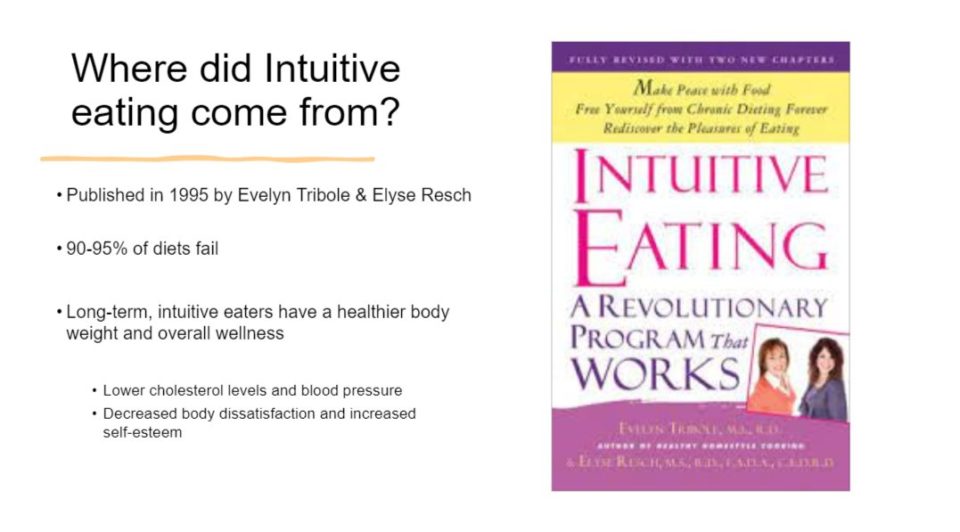
A little bit of background on intuitive eating. It shocks me that it was published in 1995 because I just feel like not that many people know about it. It was created by these two women, Evelyn Tribole and Elyse Resch, that were both registered dietitians, working separately, and did not know each other.
They would see clients come to them for either weight management, or helping them to lose weight, so, of course, nutrition plans were given, and they would try to introduce snacks and have that brownie that you like, the type of thing every now and then. And they just kept finding that all these clients would come back and say:
“It’s not working. I’m not losing weight. It’s not working. I’m doing something wrong. I must be doing something wrong, and we’re so guilty”.
So they just thought to themselves: “Are they doing something wrong, or is it the bigger thing of the way that we’re approaching eating and dieting?”
Their research shows us that, as you can see here, 90% to 95% of diets fail, which seems kind of crazy. But if you think about it, if you have a history of dieting, there’s a chance that you’ve been on more than one.
I think it’s hard that someone has only been on one diet. It ends up being a cycle. You get on a diet to lose weight. You lose 10 pounds. So you’re off the diet, you start eating like normal and you gain weight. You need to diet again, and it just becomes like this. Therefore, they don’t work.
The research has also shown us that long-term intuitive eaters actually have healthier body weight and just overall general wellness than those who continue to diet and restrict their intake and other things.
For intuitive eating:
- lower cholesterol
- lower blood pressure
- increased self-esteem
- increase exercise
- increase confidence
- mental well-being
- decreased body set dissatisfaction
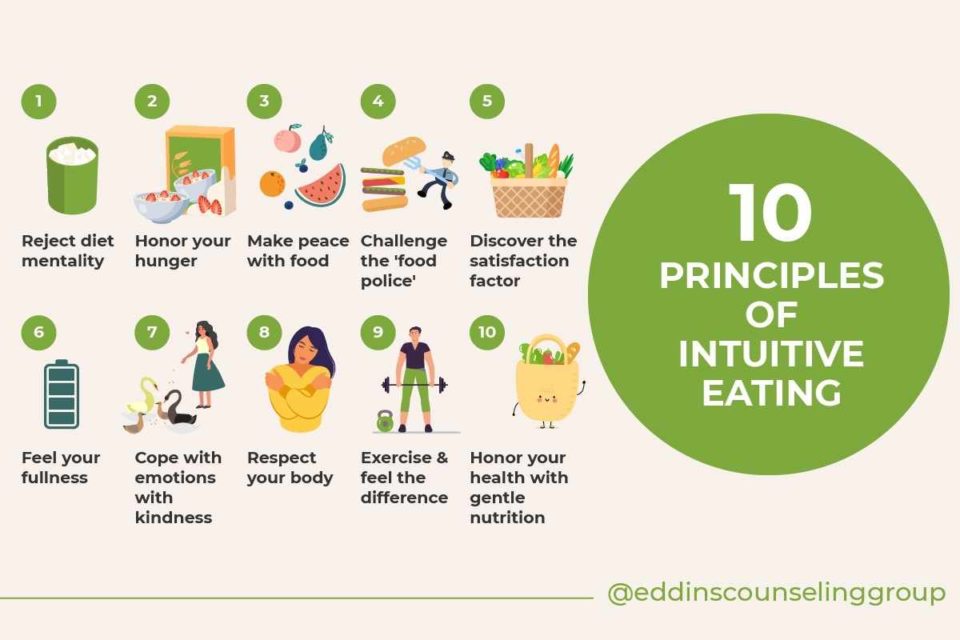
10 Principles of Intuitive Eating
Next, we’re going to kind of start getting into what are the actual guidelines or principles of intuitive eating and what it looks like to do those in your daily life, when you’re at work and you’re doing a million different things and you don’t have a lot of time, or you’re running kids around all their different activities.
It’s awesome to know these things to do, but how do I actually do them? How does this look realistically?
#1: Reject the Diet Mentality
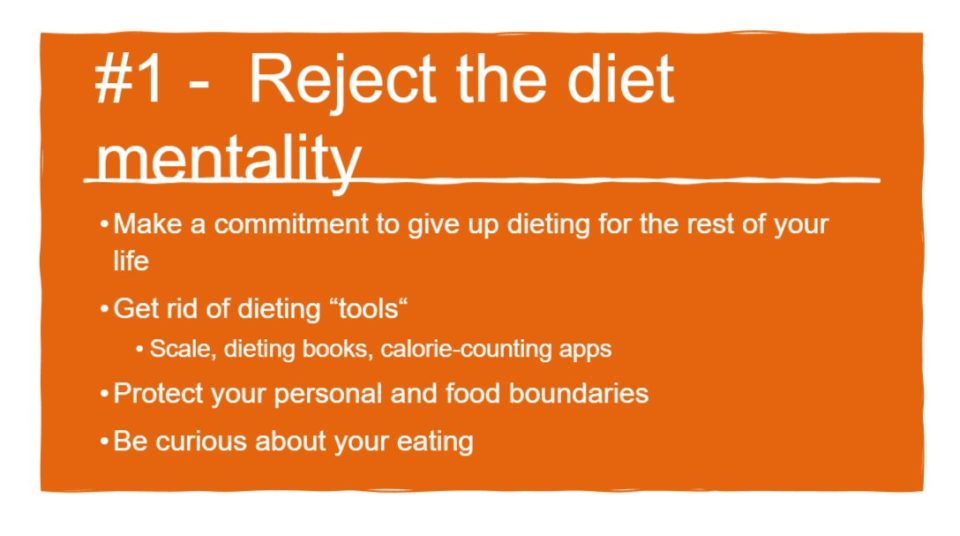
The first premise of intuitive eating is to simply reject the diet mentality. And I know that’s a big ask because this has just become ingrained so much in the way you think and just the way you are being. A part of this is to be reflective and think realistically: “Where has the dieting got me? Do I feel better about myself when I lost weight and have all my troubles gone away? When I gained the muscle, have all my troubles go away? Am I happier just like? Where has it gotten you? Do you feel like you’re in a better place?”
The chances are the general answer is probably no. Understanding that it doesn’t work, and being in a place where you’re ready to take action against that are two different things. This is because people can be in different places, like with their view of diets and their intuitive eating.
Intuitive eating is not a simple process.
You can know that diets are wrong. You can be exhausted, you can be burned out from them. But actually doing this thing which is going to make you face your fear of possibly gaining weight is really scary. So this seems like such a simple concept, reject the diet mentality, but it’s complicated, it’s scary.
I just want to assure you that it is hard at times, and I don’t want it to be oversimplified into this very easy thing because it’s challenging. But I want to say before we go into all the principles, although these are ten steps and they’re like in a specific order, they don’t have to go specifically to that order.
It’s a very good chance that you’re in stage one and stage three or you’re in stage five and then suddenly you’re back in stage two. It can go all different ways and they’re just guidelines, just a general premise. So I want you to keep that in mind because I don’t want you to think you’re doing it wrong or thinking: “I’m not moving up to the next stage”
Again, with that, there’s not a designated timeline for how long it’s going to take you to get to be an intuitive eater. There’s not a designated amount of time it is going to take you to fully reject the diet mentality, accomplish and move on to stage two. It’s not set, and it’s different for everyone. It depends on your past history with eating, and how far entrenched these dieting thoughts and rules you have in your head. It varies. This is not a diet, you cannot do it wrong. I just want to reaffirm that.
Get rid of the dieting “tools”
But back to going into rejecting this diet mentality, as you can see in the image above: Get rid of the dieting “tools”. All the things in your house such as your scale, any particular calorie counting cookbooks, Weight Watcher cookbooks, calorie counting apps, or my fitness pal.
Get rid of those things that actively aid you in dieting. We need to remove them. That way, as you’re starting this journey, you’re not tempted to use those things. And even along the process, you can be thinking: “Oh, I’m really making progress”. And then the scale is there and you step onto it and suddenly all that progress in your head has been wiped away. So we want to get rid of those things, those measurements of progress because progress and intuitive eating look much different.
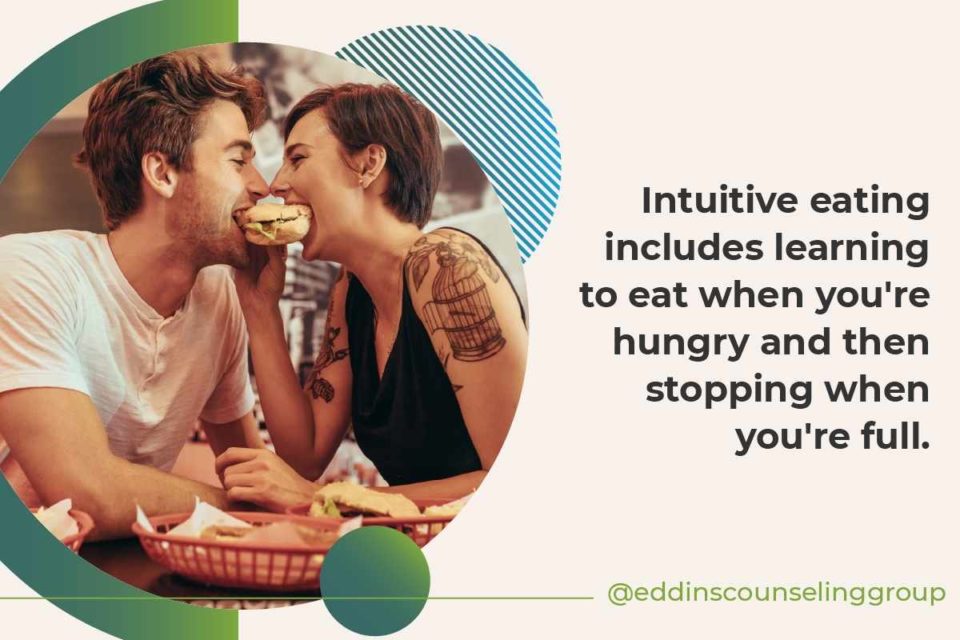
Protecting your personal and food boundaries
The way that you’re going to begin eating is different than what you have in the past with dieting. So a part of this and with intuitive eating is learning to eat when you’re hungry and then stopping when you’re full. We’re not restricting and we’re not overeating and trying to find that healthy balance in between.
The people around you can be really accustomed to a specific way that you eat. For example, you’re normally the person who has a salad, or you only eat half your meal. So you go out to dinner with friends, and instead this time you order a bowl of pasta or a steak, or you do eat all of your food. It’s likely that your friends are going to turn to you and be like: “Wow, you had a lot today. This looks different”. And they’re going to notice.
Be curious about your eating
A part of protecting these boundaries is communicating with the people in your life who might be mindful of your eating patterns and that you are trying something different. “Hey, I would appreciate your support in this. This is new for me”. And that way you kind of have an ally in the process, somebody to support you along the way. And even if those comments are made, like at dinner or at lunch, at work, or anything like that, feel free to speak up. It’s okay to say:
“Yes, I’m eating differently now. I would appreciate you not commenting on how much I’m eating. I would appreciate you not commenting on how much I’m eating, what I’m eating”.
That’s okay, protect your space. And then just as you’re beginning this process, I think a mindset of curiosity is key. Just be curious about your body. Be curious about the way your body feels. Be curious about what foods you’re wanting, and how certain foods make you feel. So we’re not coming at this from a judgmental state, we’re just coming at it from being curious.
#2: Honor Your Hunger
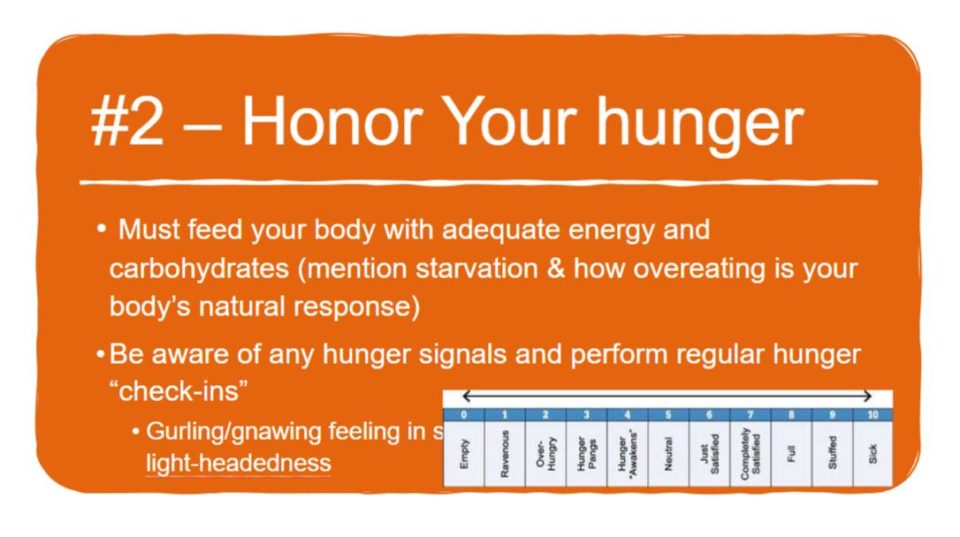
Number two is to honor your hunger. This one is basically saying, eat what you are hungry for, eat what the quantity that you want. We’re so used to restricting or eating particular types of food, only healthy foods, only these particular quantities, only within these boundaries of not after 09:00 p.m., not before 10:00 a.m., etc. But that’s eating with your head, that’s not honoring your hunger. That’s not listening to your body.
Must feed your body with adequate energy and carbohydrates
You need to be sure that your body is fueled with adequate energy and carbohydrates. With this starvation right here, there’s this concept in intuitive eating about like a starvation response.
You’re constantly in a state of restriction, whether you’re actively restricting, you’re not eating a lot, or if you’re in your mind restricting, telling yourself: “I shouldn’t be eating this, I ate too much”. That’s a restriction too.
Even though you might be eating those things in your head, you’re restricting and saying, no, shouldn’t do that. No, that was bad. Those types of things, any kind of that restriction are going to trigger you to overeat because you’re telling yourself: “I can’t have this”. So clearly you want it. That’s normal.
Be aware of any hunger signals and perform regular hunger “check-ins”
So honoring your hunger, and giving your body what it wants. A part of this is going back to being curious and mindful, being aware of any hunger signals, and then checking in with your body or hunger check-ins as you’re eating.
It’s really easy to just be on the go. We see eating as this thing that is just like this necessary component, like who has the time to stop and think about what their body is doing and think about: “Am I hungry?” If your lunch break is at 12:00 and you don’t eat until you get home later in the day, you eat at 12:00 whether you’re hungry or not. And sometimes that’s just the way it is.
But if that is the way it is at work, you only have a 30 minutes lunch break and it’s 12:00, that’s okay. Let’s take the time to think to yourself before you eat and check in with yourself and think: “Am I hungry? Am I physically hungry? And am I feeling a little lightheaded?”
It’s common to get that kind of like really gurgly, aching, non-feeling in your stomach. Maybe you have a light headache. “Am I physically hungry? Or is my body giving me signs that I’m hungry?” Even just taking that pause to check in and see where you’re at.
Hunger Scale
I put this down here at the bottom of the presentation a hunger scale. When you’re not used to even like being aware if you are hungry or not. Because again, we’re thinking with our heads, we’re eating with our heads. It’s hard to tell.
Sometimes you need a baseline or some form of reference to see where you’re even at. And so down here is a little scale you can use. Zero obviously means completely starving. You need to eat, ASAP. Ten – we’re really full, we’re really uncomfortably full.
If we’re trying to prevent restriction and we’re trying to prevent overeating, we need to prevent being down here in zero to two. If we’re down by zero to two, we’re going to get into overeating. And then after we eat, we want to prevent, we want to fall into kind of this range of seven and eight – satisfied in full. That’s kind of what we’re shooting for.
So just before you eat, check-in, where am I on this scale? And then during your eating, check in again, and try to eat a little slower than usual. And as you’re going think: “Okay, what number am I now? Oh, I’m still a three. Okay. All right, cool. Going to keep eating. A couple of bites later, I think I’m a six now. Okay.”
Just even being mindful and just practicing, having some awareness again. I think the term practicing here is huge. That’s what this whole process is – practicing.

Make time and prepare to eat
I know everyone is probably so busy and slammed doing so many different things is having adequate snacks. If you’re at work, keep some snacks in your drawer for when you get hungry so you can prevent getting down here to a zero to two. Keep some snacks at home, and keep some snacks in your car.
Be prepared to eat. So we’re preventing getting down here to a zero to two and then overeating. So be prepared. Take the time to go to the grocery store, and order from Instacart. Just be sure you have an adequate amount of snacks.
That way you’re not scared that you’re not going to have something to eat either. You know that if you are hungry, you have something. We’re trying to prevent getting down here from zero to two.
#3: Make Peace With Food

The next one is to make peace with food.
Deprive leads to drive
Obviously, this is a huge one, and I just want to say this first one Deprive leads to drive (last supper eating) makes so much sense to people.
Say it’s the Sunday night before you start a diet: “Okay, I’m not going to eat this pasta after tonight. No more carbs, no more pasta. I’m not going to do it”. So you’re starting depriving yourself, and that mental restriction so you’re going to overeat. You’re going to overeat because you’re not going to get it later.
So it’s referred to as like last supper eating. So again, going back to giving yourself what you need, providing yourself with what genuinely sounds good in your body is telling you you need. We’re not depriving.
Food is not “good” or bad”
Having adequate food available with making peace with food is really how are we stopping that mindset of thinking food is good or bad? “Oh, I ate chocolate. I ate really badly today. I ate badly”. Those types of things. In reality, it doesn’t exist.
Food does not have value. It is just food. It’s the diet culture in society that has told us what is good and bad. And so through this process, trying to make out the difference as well in what’s going on in your head. Is this actually you? Is it you that’s having these thoughts? Or is it diet culture? Trying to distinguish between those two because we want to get this diet culture to be quiet. We don’t want that one, we want you. We want your body to guide the eating and what you want.

Give yourself this unconditional permission to eat
By making peace with the food, we’re not restricting. Give yourself this unconditional permission to eat. Say: “I’m allowed to eat whatever I want, I can eat whenever I want”, knowing that you’re going to have another chance. You’re not going to have to stop eating or restrict yourself again. There’s no this deadline for when you can eat or not. So give yourself that permission. And by that permission, it just takes this weight off your shoulders.
Eat what you want
So eating what you’re actually hungry for, whether that you want a chocolate bar, eat the chocolate bar. So when you have a snack or when you have a meal, if you find these thoughts coming up of “Wow, that was really bad, or ate really poorly”, be curious, where are these thoughts coming from? Is it diet culture or is it me? Remind yourself this food is not bad. This food is simply food. I wanted it, and that’s okay.
Keep adequate supplies of any foods you think you might want
Then going back to prevent not having enough food, preventing that restriction and getting down into that zero to one or two of being really hungry, be sure you have enough food. And not only do you have enough food in areas that you would need to quickly grab it, but be sure that it’s food that you want. Be sure it’s actually food that you’re going to enjoy. Because if you enjoy it, there’s a better chance that you’re going to feel satisfied and we’re not going to end up in the 8,9, or 10 of eating on that scale.
#4: Challenge the Food Police
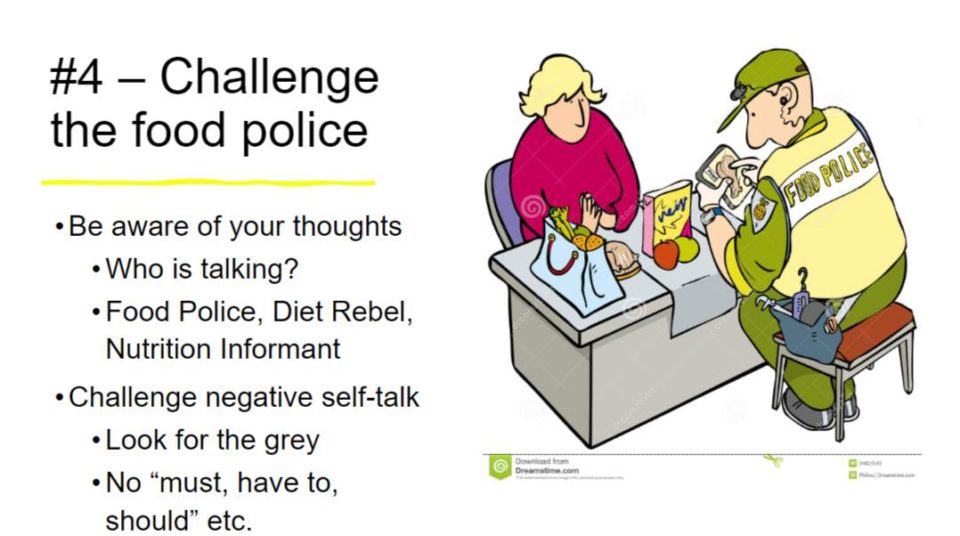
Do you think this is the diet? Is it diet culture or is it actually me? It’s challenging the food police. Be curious about who is talking. I’m sure if I asked you to think of your food rules, you could probably make a pretty decent list of your food rules, all the things that you’re not supposed to do.
But checking in with yourself and who is talking. We want you to be talking. You want your body to be talking. And a lot of those rules are probably going to look like black and white. All or nothing.
“I cannot eat chocolate. I can only have pasta once a month. If I eat over 1500 calories today, then I did bad, then I lost, then I’m a failure, then I’m not trying hard enough.”
All these things are black and white. There’s no other option. And so when you find yourself having these thoughts, I think just simply a good way to think of it is looking for the gray, look for the middle ground. So for that “I can’t have over 1500 calories, then I was a failure. Well, I didn’t plan on eating over 1500 calories, but that’s what my body needed today and I was hungry. So that’s okay”.
We’re looking for that gray. “I can’t have chocolate. Chocolate may not be the most nutritious for me, but I was really craving it today. I had it and I really enjoyed it.” Or like say it’s like a holiday or an office party. There are cupcakes and you’re thinking” “I really don’t need to eat these. Well, this is a special event. I deserve to have a cupcake”. That’s fine. Look for the gray.
#5: Respect Your Fullness and #6: Discover Satisfaction

The next one is honoring your fullness, looking for that level of seven to eight. With eating we get so caught up with everything that we need to do that just like, food is like something that we need. We just have to eat. It’s an afterthought. You just do it.
So try to find the time when you’re eating to decrease your distractions and then be more mindful. If you can have time to yourself to eat on your lunch break or a quick five minutes to yourself at home while the kids are watching TV or something, take that couple of minutes to yourself and really focus on what you’re eating.
Checking in with your hunger and checking in with your body:
- How hungry are you and what does your stomach feel like?
- What does your stomach feel like before you’re eating?
- Is your stomach feeling stretched?
- Is your stomach feeling, really growly?
- Is it feeling compressed?
- Are you feeling bloated?
Ask yourself, after you eat, what do you feel like? And knowing those feelings, which feelings do you like? Or do we feel uncomfortable when the stomach is stretched?
Do we feel uncomfortable, and bloated after we’re done eating? Or, do you feel tired? Do you feel energized?
And just kind of having this awareness of what fullness feel like and which feeling I like is enjoyable? And then going along with that and not restricting, keeping ourselves from that bottom of the hunger scale is figuring out what you want to eat.
Often with dieting and everything, you eat what you’re supposed to.
Even going so far sometimes I think people convince themselves: “Oh, I don’t like this food”. I did that at one point. I was like: “I don’t like ranch dressing.”
And I would always tell people when they asked about what salad dressing I wanted, I said: “No, I hate ranch”. I absolutely do not hate ranch. I love ranch. But it was easier to tell me that I didn’t like it because it made it less appealing. So pushing those things aside when you’re feeling that hunger, or again, we are trying to be prepared ahead of time if you’re planning your meals for the next day, like planning out your lunch for the next day, making that grocery store list before you go and get the whole week’s worth of food, ask yourself:
- What do you really want to eat?
- What sounds good?
- What kind of taste or smell or temperature are we looking for?
- Do you want something warm?
- Do you want something cold, crunchy, spicy, or salty?
Really taking the time to think about those things increases what you want to eat therefore, you are more satisfied and likely to stop eating at a comfortable level of fullness.
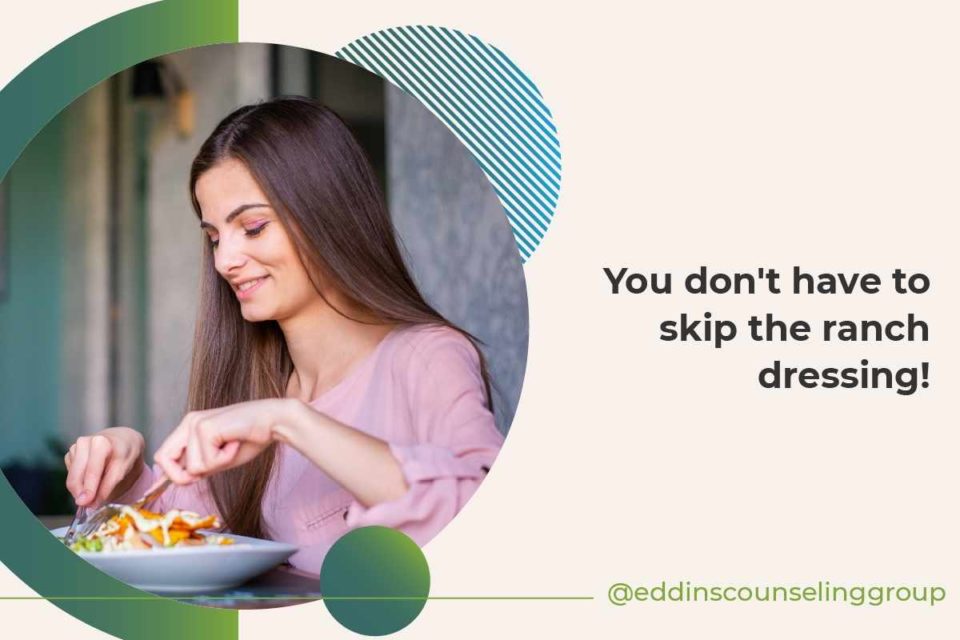
Don’t settle for eating things that you don’t want to eat. If you don’t like it, don’t eat it.
You don’t have to force yourself to eat anything that you don’t want to anymore. We’re eating things that you want. It’s all good and well to truly try to do these things. It’s a lot of things to implement, but the truth is right here, every meal is not going to be ideal sometimes. You’re going to have to eat the cheese that you don’t really care for or something you order comes with a side of broccoli or something. It’s not going to be ideal sometimes.
And just remember, one of these instances or several of these instances is not going to make or break you. You didn’t do it wrong. You’re practicing and it’s just a process. That’s all it is.
#7: Honor Your Feelings With Food Without Using Food
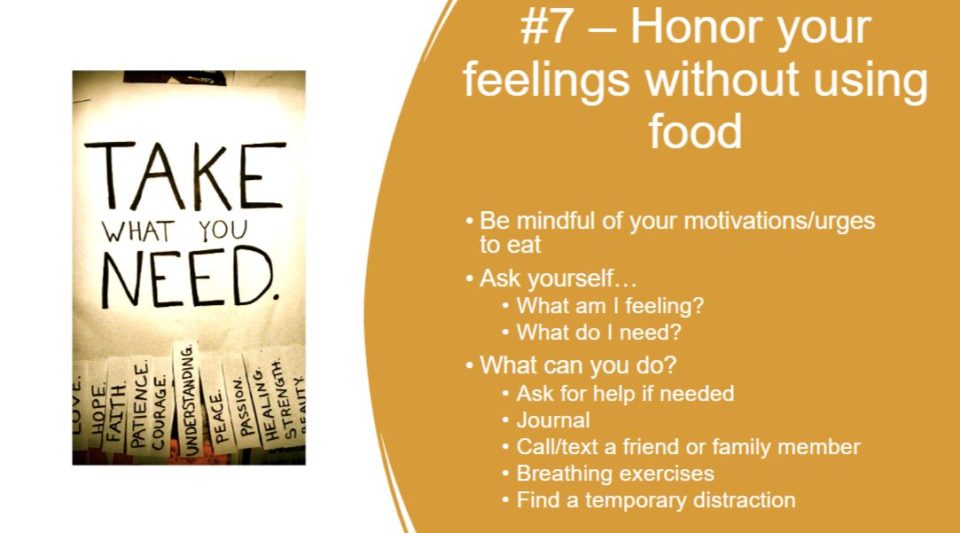
Next is to honor your feelings with food without using food. We learn from such a young age that food is used to soothe us and comfort us, and it’s used in even celebratory birthdays cake, Christmas, Thanksgiving, and Halloween. Food is a huge part of those celebrations.
A lot of the time with food being soothing or comforting, it’s really covering up something else. If we’re using food to soothe or comfort us, there’s something deeper going on. There’s some kind of uncomfortable feeling or maybe some kind of need that’s getting met and being curious about what that is.
When you go to eat and you’re checking in, thinking: “Where am I on the scale? 0,1,2 or 3, et cetera. Cool, I’m hungry, I’m going to eat. Awesome. Check. Continue to eat.” But when you find yourself being around closer up to that six, seven, really not physically hungry, then what’s going on, what else are you feeling? Is there something specific that you’re missing?
Feelings Wheel
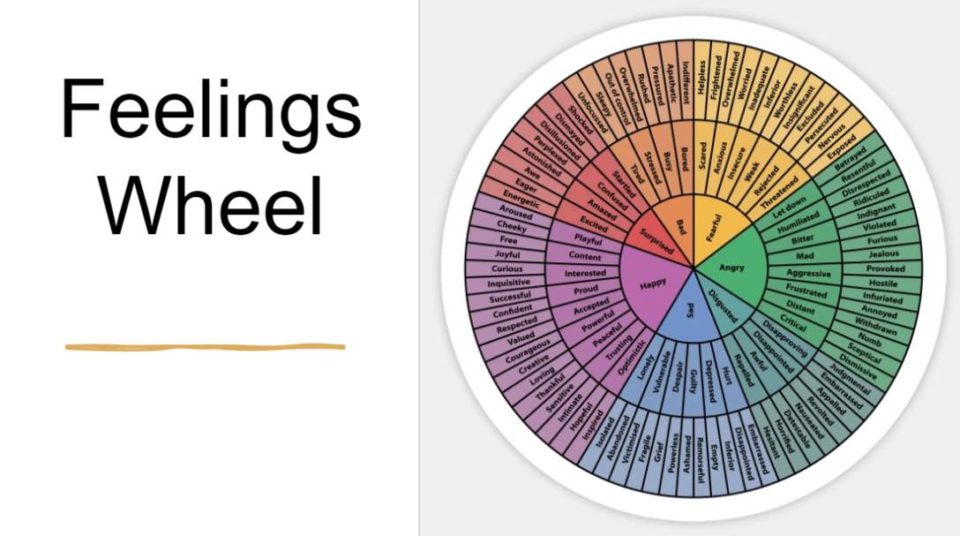
This is something called a feelings wheel. I think people have a hard time identifying their feelings because we’re really just not used to having this whole feeling vocabulary. So I think this makes it a lot easier because in the middle, you do have just the main feelings, but being able to specifically break it down and really hone in on how you’re feeling, I feel like it’s so validating. And by acknowledging what you’re feeling, you can figure it out, what you need, what you actually need.
Maybe you need support, maybe you need a hug. Maybe you need time to yourself to just take a breath, reassurance, connection, a different variety of things.
So once you’ve identified what that need is, what can you do to meet it? And there’s a variety of things on the image above if it involves somebody else. If you need a hug, ask your partner, ask a friend, your child: “Hey, I could really use a hug right now.”
You might have to actually verbalize and ask for help, which can be challenging but rewarding. If you’re trying to still figure out what that feeling might be or what that need might be. It’s. A good idea to journal. Just get it out there. And somewhere along the writing, I feel like generally, you start to figure out what’s going on. Or call or text a friend if you’re really feeling some negative, uncomfortable emotions.
Try to just take a breath, breathe it out, give yourself a second, give yourself time to calm down, and check in. And then lastly, if we can’t figure it out but we’re still feeling that urge to eat, just find a distraction, that’s totally fine. You can call a friend, watch your favorite sitcom, watch an episode of that, or go play a video game. It’s okay to distract yourself when you need it because again, it’s a process and we’re trying to figure it out.
#8: Respect Your Body
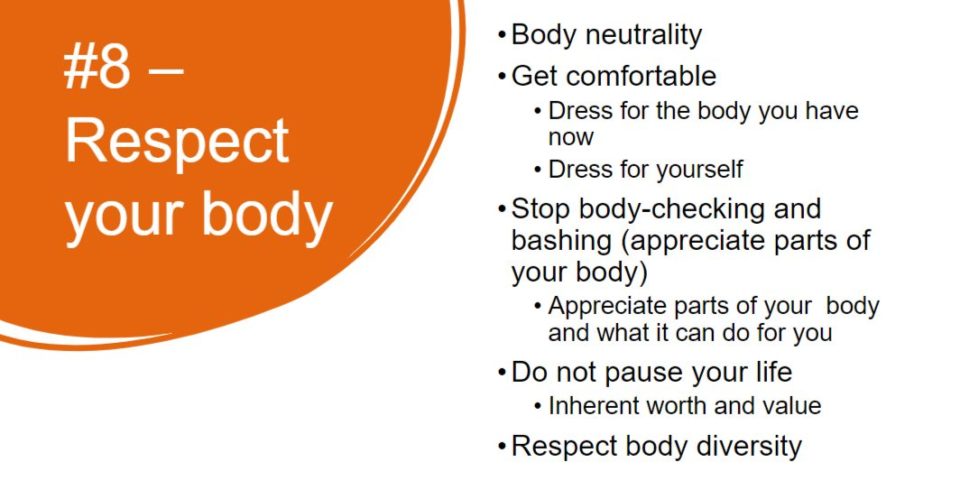
With respecting your body, the keyword is respect, not love. Nobody says that you have to love your body. I feel like there’s so much pressure on that whole instance.
Think of it as like somebody in your life that you don’t particularly love, but respect them. You’re still going to treat them with dignity. You’re still going to treat them with kindness because that’s what you do. You respect them. And so a part of respecting your body is dressing for the body that you have now.
Stop holding on to those jeans that fit two years ago that you’re trying to fit back into or wearing the clothes that are so tight because you’re scared to buy that size up or that size down. That’s not dressing for the body you have.
By keeping those things, we have constant reminders and comparisons of what you’re not now. Constant reminders of what you were then or what you could be. If you keep dieting if you’re wearing clothes that are so tight, having the tightness on your body is a constant reminder and awareness of drawing you back to your body.
Dress for the body you have now and dress how you want to.
Don’t dress the way that you feel like you’re supposed to because you’re a certain size. Dress how you want to. What makes you happy to express yourself in the way that you dress, that’s okay. You don’t have to wear these over baggy clothes or bigger clothes or anything like that because people are more comfortable with it for us the way that you would like and that you are to feel your most confident.
Along with this, stop body checking so much. Sometimes what that looks like is not looking in the mirror, go into the dressing room. Sometimes that looks like turning away from the mirror and trying your clothes on. If we know looking in the mirror is going to trigger you, let’s prevent that. Sometimes it’s simple as that. We have to not put ourselves in positions to feel bad, feel the guilt, and everything. Appreciate your body for what it does for you. Find the little things about your body. There are some things about yourself that I am sure that you love.
Maybe it’s something small. Maybe we’re starting with like an ankle or fingernail or something, but we’re starting small is good. Appreciate your body for what it does for you. I walk to work. It gets me to work. It holds up my kids on my shoulders, playing at the park. Your body does so much and has so much more value than the way it looks.
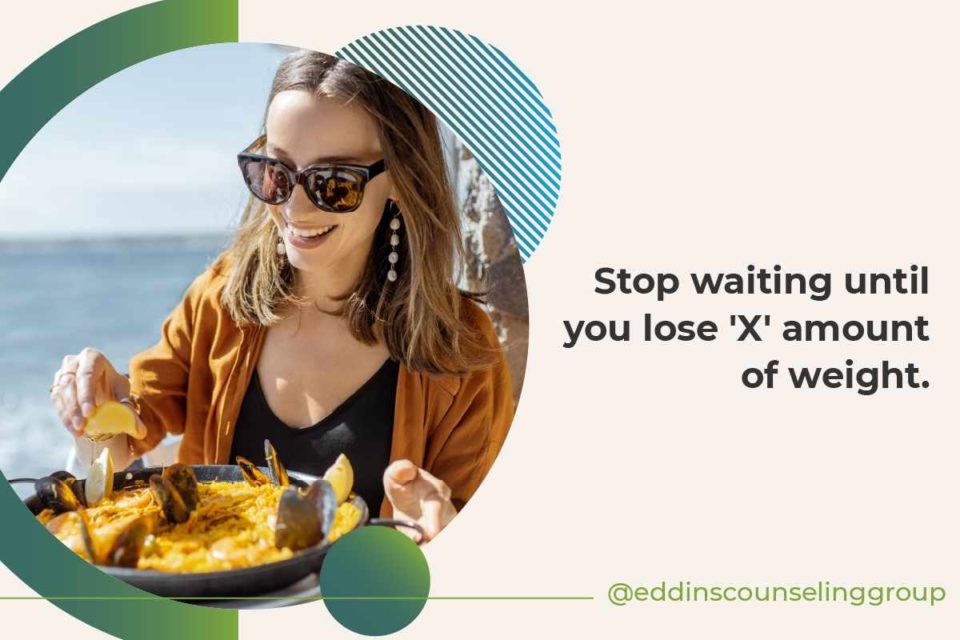
Stop waiting until you lose this X amount of weight, or until you have more muscle, etc. Look for a certain way to do certain things.
Do not put your life on hold. You are not valuable and worthy only because you look a certain way. You are valuable and worthy just as you are, just because you exist.
So stop living this story, this lie of thinking: “I can’t do things until this”. No! You can! Your life goes on. So don’t wait and don’t pause. Just remember that you deserve respect and you have value.
Regarding respecting body diversity, in my head, I think with social media, a lot of the time we fill our social media with things that with people that we want to look like that. At one point when maybe we started in this journey with motivation, thinking “we want to look like them”, we follow their workouts, that type of thing. If they make you feel bad now, unfollow them.
Follow people with more diverse body types, larger body types, smaller body types, and different body types than yours. Just even giving yourself exposure to these other kinds of bodies and thinking: “Hey, this is okay. This person is confident, they’re beautiful, blah, blah, blah”. Like, just getting yourself used to that.
#9: Joyful Movement
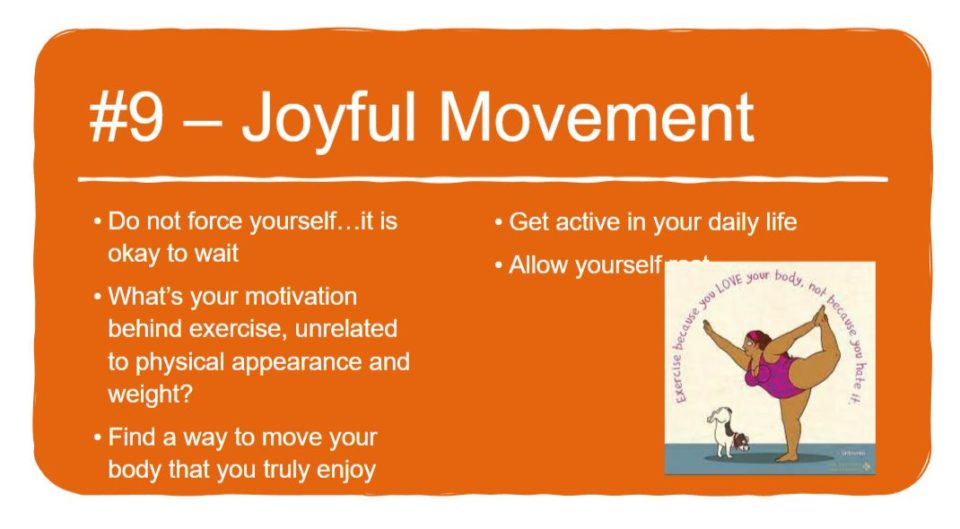
As we get on this journey further down, we continue to exercise. And so much time has been spent often using exercise as punishment. It’s a means to an end, something you make yourself do to look a certain way. There may be quite a period of time that goes on during this that you don’t want to work out, because it’s just still really aversive, still really feels punishing. And that’s okay. It is totally fine to wait. Six months without working out in the span of an 80-year life, you’re going to be all right.
And then think about what is the motivation behind the exercise different than your appearance.
Do you want to feel less stressed out? Does it make you feel more accomplished after working out? Can you have more energy to play with your kids when you get home from work? What are the motivators unrelated to your appearance?
We’re sold this idea, and it comes and goes with the trends that there’s one way to work out and this is the best way to work out. That’s not true.
The best way to work out is the way that you enjoy the most.
Sometimes it’s hard to figure out what it is so try different things. With Covid, there are so many virtual online classes that places are offering now. So there’s a wide variety of things out there that you can find with a simple Google search.
Particular gyms and facilities offer free class passes, lots of options to figure things out, and then even just beginning to incorporate activity in your everyday life. Park your car a little farther from your building, or park on the second floor. Take the stairs. Just those baby steps into getting used to your body exercising and feeling the positive side effects of that.
#10: Honor Your Health

The last one is to honor your health. Basically, this one is incorporating nutrition back into your eating. Sometimes this can take a few months and you’re starting to feel that you want fruits and veggies again or whatever you restricted from before. But sometimes this takes a long time. And just remember that it is not a timeline.
The focus here is eating healthy. So how do eating healthy things that are going to properly fuel your body while also maintaining that relationship with food? Sometimes you start with eating broccoli and cheese. These are baby steps, whatever you like and enjoy and it might be healthy for you.
As you’re kind of eating these things you are paying attention to your body:
- How does it make your body feel?
- How does it make your stomach feel?
- Are we bloated?
- Are we stretched?
- Are we feeling tired, energized, etc?
Just pay attention to how this food affects how you’re physically feeling. Getting back in touch with your physical feeling of eating and hunger. Just start slow with this. It is such progress. And then continue throughout this process. Remember, it’s a process. You can’t do it wrong.
I encourage you to view it as practice. It is challenging. It is really scary at times. You’re trying to undo ways of thinking from years of particular things. So just be encouraged that you’re on the right track and there’s no right way to do it. You’re going to do your best.
When working with a client who needs to learn how to eat intuitively, what do you begin with? Which of these steps?
That is an excellent question, and I think the way to start is by acknowledging that dieting hasn’t been successful, because I think it’s so easy to hang on to this idea that you didn’t try hard enough. You’ll just try one more type of mentality.
But really just taking a step back and really thinking about it in the bigger picture of where has this gotten you? Where has the dieting got you? Have you seen the long-term progress that you wanted? So just coming to terms with that dieting has not been effective, and we need a different approach, and we no longer can continue to diet. Just having that general acknowledgment and just acceptance is the best place probably to start.
Next Steps:
To schedule an appointment with Katie Osgood, click here.
My office is a safe space just for you, to take a pause from the stress from everyday life and feel supported in challenging times.
I offer in-person and virtual counseling to individuals 14 years old and up who are facing a variety of challenges including eating disorders, depression, anxiety, perfectionism and more.
References:
Here are a few resources here that I think may be helpful to refer back to:
- Conason, A. (2014). The evidence for intuitive eating. Psychology Today. https://www.psychologytoday.com/us/blog/eating-mindfully/201406/the-evidence-intuitive-eating
- Tribole, E. & Resch, E. (2003). Intuitive eating: A revolutionary program that works. St. Martin’s Press.
- Tribole, E. (2019). Principle 10: Honor your health with gentle nutrition. Evelyn Tribole: The Original Intuitive Eating Pro. https://www.evelyntribole.com/principle-10-honor-your-health-with-gentle-nutrition/

